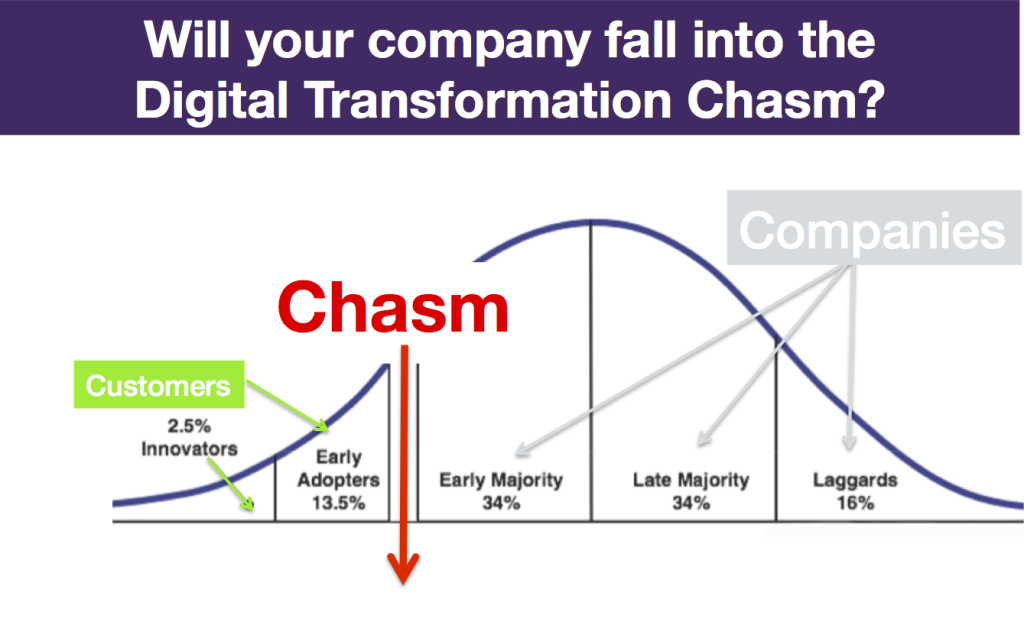We Are Out of The Hype Cycle: Digital and Social Applications Must Solve Business Issues: I know when I first started to learn about social media and digital applications, I could see how they could change business. It made sense to me. I think because I am an early adopter. I’m referring to Geoffrey Moore’s technology adoption curve. There’s the innovators, who create all this cool new software. And then there’s early adopters like me, that look at those innovator’s inventions and realize the impact they can make.
Having been in this business for a long time, one of the things that I realized was that not everyone can see the value of social and digital. It’s not an intuitive thing for them. And there’s nothing wrong with that. It just is what it is. And that’s why businesses (vendors) who are in the business of selling products and services really need to take a look at their product management and product sales teams. Are they organized to sell to those that “already” get the value? That’s like selling ice to eskimos. The people who get it, already bought your product.
MY POV: Where the rubber is now meeting the road is learning how to articulate the business value that digital and social applications, products and services provide. I am lucky to hear a lot of briefings on new things. However, what I am finding is that some companies need to really look at where the marketplace is in adoption of the new technology and perhaps shift some of their marketing messaging, but even more important to look at who are the persona(s) that they are developing products and services for? Are they for the early adopters? It’s a small part of the marketplace. Or is is for the early / late majority? That’s a much larger part of the marketplace.
Early Majority Want Your Help to Say Yes: And that part of that part of the marketplace (early majority) requires something different to convince them that they need this “new” product. They want to know what business challenges does it solve? They want to be shown how someone else had a “burning issue” and this product or service solved it and what the outcomes were.
If your sales pitch is not lined up that way, you maybe missing the market on the largest part of the marketplace. Don’t take it from me; reread Geoffrey Moore’s Crossing the Chasm— it’s all about changing how you market and sell as the marketplace matures. Those who do, will find prosperity and those that don’t, won’t.
 What Do You Need To Do Now? The key is to be able to articulate the business value. What is the business issue that your product or service solves? To know that, a business has to be really clear on who they are selling to. That means they need to define various personas and know what those personas face as daily challenges. They need to map out the-day-in-the-life of that professional. And they need to do this by going and talking to 10 or 20 or 100 of them. Don’t assume anything. Then align the challenges those professionals face with the solution you offer and can show an early majority person how your new “product or service” can solve their issue better than anyone else.
What Do You Need To Do Now? The key is to be able to articulate the business value. What is the business issue that your product or service solves? To know that, a business has to be really clear on who they are selling to. That means they need to define various personas and know what those personas face as daily challenges. They need to map out the-day-in-the-life of that professional. And they need to do this by going and talking to 10 or 20 or 100 of them. Don’t assume anything. Then align the challenges those professionals face with the solution you offer and can show an early majority person how your new “product or service” can solve their issue better than anyone else.
References, References, References: And having customer references is key, especially early majority customer references. Why? Because early majority folks convince other early majority people to take a chance at these new technology, processes and services. They believe each other more than they believe the vendor or even sometimes an analyst.
Watch Your Language: There’s lot’s of languaging issues in the current marketing of software and products / services. Almost everyone can claim to be influencing some aspect of customer experience. And by not articulating the business case of how that product or service clearly affects the bottomline, the buyer is confused and that slows the sales cycle down.
Understand Buying Signals: Your potential customers probably won’t say anything; they might say things like, “Hmmm looks interesting. Call me in a few months.” or “Send me a brochure.” NOTE TO SELF: Those are NOT buying signals. They are polite ways of saying, “I don’t have time for this; I don’t see how this applies to why my hair is on fire; I am not sure how I would apply this to what is happening in my department or company and I certainly have no idea how I am going to explain this in a business case to get my boss to say yes.”
Do The Work: Don’t make your customer do the hard work. Create those business use cases. Create scenarios that the early majority can see themselves in. Articulate, even if it’s a back of the envelope calculation, the return on their investment. If you do this, it will make all the difference in your sales cycles, in your revenue and profits and your market position. If you don’t, someone else will.
Time to relook at where the marketplace is in the maturity of the digital disruption and stop all the fanatical “speak” and get down to business. At least that’s my take. What’s yours?



